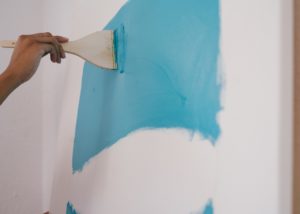Color always affects your environment. When we’re staying somewhere in which the colors are vibrant, we feel energized. Subdued colors, in contrast, make us feel calm.
In a rental property, landlords usually use neutral colors like white, gray, beige and cream to avoid a strong color palette. It’s also easier to maintain until a repainting session is due. If a landlord has multiple properties, there will be less confusion when using only a certain color palette.
Being in the rental business, you’ll experience a tenant approaching you with the hopes of painting your rental unit in a different color. He might also instead want an accent wall to break the boredom of looking at a neutral paint color. Should you agree to the wishes of your tenant?
There are pros and cons to allowing a tenant to proceed with repainting your rental property in a different hue. Below are some of the advantages and disadvantages of this situation:
Pros
#1: It evokes a sense of home for a renter.
When one can exercise a degree of autonomy in terms of decorating and painting, that individual can feel a sense of home. This can come when you permit a tenant to choose the kind of paint color he wants. Granting a feeling of ease to a tenant in his environment is any landlord’s goal.
#2: It creates an incentive for a long-term stay.
When a tenant is comfortable with where he’s living, he’s more liable to stay longer. Even if the rent price is raised a bit over the years, there’s a good chance that the renter will keep on renewing his lease. Being comfortable with his surroundings can be akin to having a sense of ownership.
As a landlord, if you let your tenant paint an accent wall or change the color palette in his rental unit, you are saying that the tenant has a privilege here, making the tenant feel more at home.
#3: It can result in happier tenants.
A rental property business can be competitive since similar properties are offering similar features. A landlord will continually look for ways to make his tenants happy.
Doing this builds customer retention and creates loyalty for a renter to renew his lease year after year. One of the ways you can make a tenant happy is by permitting him to decorate and paint the rental property according to his sensibilities.
Cons
#1: It presents more work to landlords once a tenant moves out.
Granting the tenant independence when it comes to repainting the unit can be arduous to a landlord. If a renter only stays for a short while or the turnovers are quick, such as every six months, it’s simply not worth the effort.
Painting can take a couple of days or a week, depending on the size of the unit. During that time, a landlord is not earning any income at all. You also have to double-check that everything is back to the original, neutral shade.
#2: Painting is considered an additional expense to the property owner.
Repainting a unit can be costly, especially if turnovers are frequent. If the chosen shades are darker than the previous paint color used, the multiplied coating cost is a huge factor. Financially, landlords would rather invest the extra cost in other, more important upgrades and renovations that would add more value to the rental space.
#3: Most tenants don’t have the professional skills to carry out a painting job.
Since most tenants want to save, they would naturally opt for a do-it-yourself painting session once you approve their request. This can result in a botched job with paint spills and less-than-attractive workmanship.
Instead of adding value to your property unit, it will have the opposite effect. As a landlord, you want to avoid this kind of situation.
Strike a Balance
Both scenarios can result in a loss for the landlord. One alternative is to allow a renter to proceed while balancing the privilege with several conditions.
Here are conditions you can agree upon beforehand:
- Who shoulders the cost for the materials and labor?
- Is the job to be performed by a professional?
- How long is the renter staying in the unit to be given this privilege?
- What type of paint spectrum is allowed?
- Will a non-refundable fee cover the cost? Will it be deducted from the tenant’s security deposit?
- Is there a tacit agreement to repaint the unit back to its original paint color once the tenant moves out?
State Conditions in the Lease
Your stipulations must in writing for the terms to be clear. It’s also best to document the rental unit before a tenant moves in.
Laying down the details is vital in cases where you want the renter to repaint the unit back to its original color theme. It’s also a good way to avoid potential disputes.
One thing to remember, however, is to avoid charging a painting session to a tenant if it’s part of your maintenance routine as part of your landlord duties. Normal wear and tear occur and as part of improving the habitability of your rental space, you will be performing maintenance tasks. One of these will include repainting your property.
Landlords typically hire a professional to repaint their Kissimmee rental properties to enhance its look and value. It would be unfair to let your tenant shoulder the cost of a repainting job when you need to do it anyway.
Bottom Line
The decision to permit the tenant to repaint the walls will always rest on the property owner. If you don’t want the accompanying hassle, you can always state it in the leasing agreement. Some landlords allow it, especially when their rental property has been vacant for a long time.
If a tenant requests a repainting session, it doesn’t hurt to give it some consideration. Being flexible might result in a consistent income down the line.
Contact TrustHome Properties for all of your real estate and property management needs.




